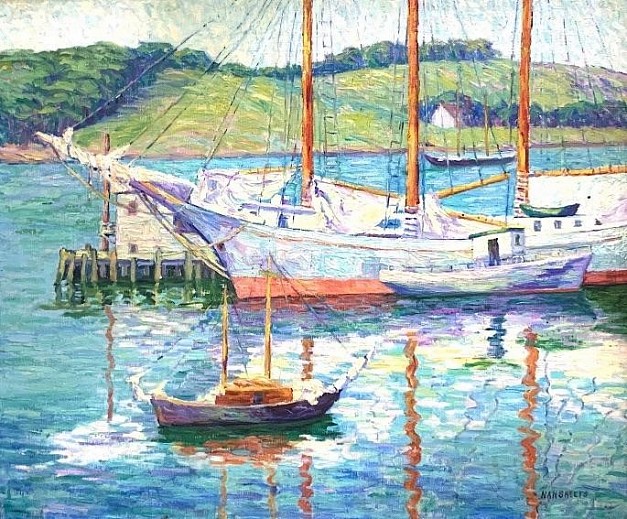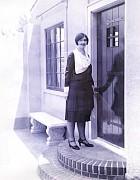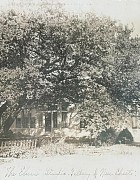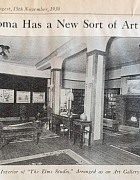




Blog: Nan Sheets - The Artist Who Made It Happen
June 11, 2020 - Joy Reed Belt
One day last week, I received a call from an attorney asking if he could bring by a Nan Sheets painting on behalf of one of his clients. I was beyond thrilled. Nan Sheets, one my personal heroes, is Oklahoma's most well-known early Oklahoma artist, teacher, pioneer and champion for the arts. Born in 1885 in Illinois, the youngest of five children, Nan inherited her mother’s talent for painting and her father’s free spirit. She graduated from Valparaiso University with a degree in Pharmacy. She immediately obtained work in a neighboring town, but soon moved to Salt Lake City, studying art in the mornings and working afternoons and evenings as the Head Prescription Clerk in one of Salt Lake’s largest pharmacies.
Dr. Fred Sheets, an Oklahoma physician Nan met in college, followed her to Salt Lake City. They married in 1916 and he persuaded her to move to Oklahoma City, at that time a city of less than 100,000 souls. In 1920, the couple built a home and resident studio they named The Elms at 2810 North Walker in Oklahoma City. Our gallery, JRB Art at The Elms is housed in that structure. A photo of her hangs near our entry.
Nan relentlessly pursued the arts throughout her life. She studied painting for several years at both the Academy of Fine Arts and the Broadmoor Academy in Colorado Springs, Colorado. She travelled frequently to arts centers and places of great scenic beauty throughout the United States to paint and to study art. She also spent months at a time abroad as a student, organizer and leader of tours for artists and arts enthusiasts. Nan Sheets truly believed in the power of the arts to transform.
The summer of 1930 Nan received national critical acclaim for her paintings and she built an addition to convert her studio at The Elms into an art gallery to show the works of celebrated American and European artists of “recognized prominence.” The Elms and the Colonial Art Gallery and Frame Shop became the first commercial galleries in Oklahoma City. Then, in 1935, Franklin Roosevelt appointed Nan to be Director of the federal government’s WPA Art Project for Oklahoma. In that role, she championed and promoted the work of Oklahoma artists including: Oscar Jacobson, Doel Reed, Edna Stevenson, Lorraine Moore and Nellie Sheppard. Nan also commissioned and funded posters, murals and other art related projects and activities which provided economic support to hundreds of artists throughout the state.
One of the her most enduring WPA projects was the establishment of a public, nonprofit art museum in Oklahoma City. While the government was willing to pay for salaries, equipment and supplies, it would not pay the rent or utilities. Nan secured the help of Stanley Draper, Sr., manager of the Oklahoma City Chamber of Commerce. He found her a room in the Commerce Exchange Building. Under her direction, the program soon outgrew the space, and relocated to a building on Second Street next to the Wirt-Franklin Building, before moving to the 4th floor in the newly completed Municipal Auditorium.
The museum had neither a collection nor money for acquisitions. Nan, with the assistance of the Oklahoma City Art League, Art Renaissance and the Junior League, borrowed and displayed art that had been collected by some of Oklahoma City’s most prominent families, including the Hightowers, the Butrams and the Shartels. The Federal Art Project closed in 1942, but Nan was convinced that Oklahoma City needed a permanent art museum. She raised the money, including $250,000 from John and Eleanor Kirkpatrick, to build an art center at the Fairgrounds. For the next 29 years, Nan served as the Museum’s Director. That institution, now the Oklahoma City Museum of Art, moved from the Fairgrounds to downtown in 2002, an effort led by the late Carolyn Hill, a woman whose vision, energy and commitment to the arts was not unlike that of Nan Sheets.
The Paseo, Oklahoma City’s first shopping center, built by G.A. Nichols, was expanded and developed into The Paseo Arts District by the late John L. Belt and is currently home to 20 galleries, restaurants, art related businesses, and about 80 artists in residence. Oklahoma City is also a center for many nonprofit, art-focused organizations including the Art League, Oklahoma Visual Arts Coalition (OVAC), Individual Artists of Oklahoma (IAO), the Arts Council of Oklahoma City, City Arts, the Paseo Arts Association, Oklahomans for the Arts, Allied Arts, Artspace at Untitled and the Oklahoma State Arts Council. These organizations promote the arts and assist young, mid-career and established artists in very concrete and meaningful ways.
Oklahoma City’s artistic offerings, also, include prominent institutions such as The Oklahoma City Art Museum, The National Cowboy and Western Heritage Museum, the Fred Jones, Jr. Museum at the University of Oklahoma, as well as the Betty Price Gallery at the Oklahoma State as well some of the nation’s most successful arts festivals. And, even during a pandemic, that energy continues to grow, as Oklahoma Contemporary opens its new facility on Broadway to share an excellent exhibition program and fabulous multidisciplinary teaching facilities. Like Nan Sheets I believe the arts are trans-formative. The arts give us the vocabulary and the platform to adapt, change and to survive in new and meaningful ways.
Images:
Nan Sheets, "Boat at Louisbourg Nova Scotia, " c. 1920's, Oil on Canvas, 20 x 24 in., $6,000
Nan Sheets, C. 1928
John Kirkpatrick and Nan Sheets
Photos Taken From Nan Sheets' Scrapbook, 1930-1936
Download Article (PDF)Back to Blogs
